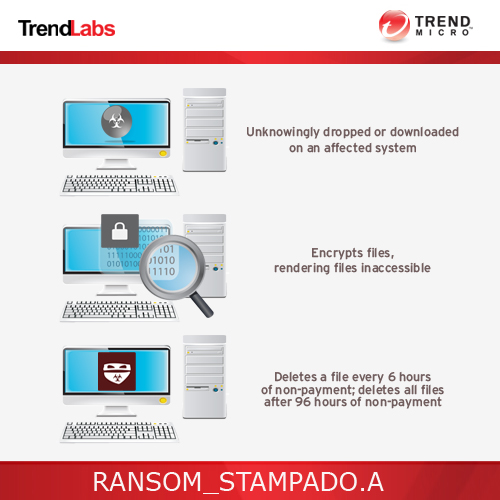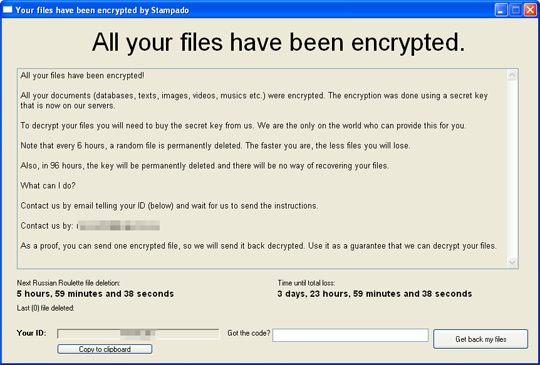RANSOM_STAMPADO.A
Ransom:Win32/Genasom (Microsoft); Win32/Filecoder.Stampado.A trojan, Win32/Filecoder.Stampado.A (ESET-NOD32);
Windows


Threat Type: Trojan
Destructiveness: No
Encrypted: Yes
In the wild: Yes
OVERVIEW
This ransomware, seemingly similar to JIGSAW ransomware, threatens to delete one file six hours after non-payment. It threatens to delete all encrypted files after 96 hours of non-payment.
To get a one-glance comprehensive view of the behavior of this Trojan, refer to the Threat Diagram shown below.

This Trojan arrives on a system as a file dropped by other malware or as a file downloaded unknowingly by users when visiting malicious sites.
TECHNICAL DETAILS
Arrival Details
This Trojan arrives on a system as a file dropped by other malware or as a file downloaded unknowingly by users when visiting malicious sites.
Installation
This Trojan drops the following files:
- %Application Data%\{random 32 hex characters} - file with larger size contains list of files that was encrypted
- %Application Data%\{random 32 hex characters} - file with smaller size contains date stamp, process id and status
(Note: %Application Data% is the Application Data folder, where it usually is C:\Documents and Settings\{user name}\Application Data on Windows 2000, Windows Server 2003, and Windows XP (32- and 64-bit); C:\Users\{user name}\AppData\Roaming on Windows Vista (32- and 64-bit), Windows 7 (32- and 64-bit), Windows 8 (32- and 64-bit), Windows 8.1 (32- and 64-bit), Windows Server 2008, and Windows Server 2012.)
It drops the following copies of itself into the affected system:
- %Application Data%\scvhost.exe
(Note: %Application Data% is the Application Data folder, where it usually is C:\Documents and Settings\{user name}\Application Data on Windows 2000, Windows Server 2003, and Windows XP (32- and 64-bit); C:\Users\{user name}\AppData\Roaming on Windows Vista (32- and 64-bit), Windows 7 (32- and 64-bit), Windows 8 (32- and 64-bit), Windows 8.1 (32- and 64-bit), Windows Server 2008, and Windows Server 2012.)
Autostart Technique
This Trojan adds the following registry entries to enable its automatic execution at every system startup:
HKLM\SOFTWARE\Microsoft\
Windows\CurrentVersion\Run
Windows Update = %Application Data%\scvhost.exe
Other System Modifications
This Trojan modifies the following file(s):
- It encrypts files and appends the extension .locked
Other Details
This Trojan encrypts files with the following extensions:
- .001
- .3fr
- .7z
- .DayZProfile
- .accdb
- .ai
- .aiml
- .ani
- .apk
- .arch00
- .arw
- .asset
- .au3
- .avi
- .bak
- .bar
- .bay
- .bc6
- .bc7
- .big
- .bik
- .bkf
- .bkp
- .blob
- .bmp
- .bsa
- .c
- .cas
- .cdr
- .cer
- .cfr
- .cpp
- .cr2
- .crt
- .crw
- .css
- .csv
- .d3dbsp
- .das
- .dazip
- .db0
- .dbfv
- .dcr
- .der
- .desc
- .dmg
- .dmp
- .dng
- .doc
- .docm
- .docx
- .dwg
- .dxg
- .epk
- .eps
- .erf
- .esm
- .ff
- .flv
- .forge
- .fos
- .fpk
- .fsh
- .gdb
- .gho
- .gif
- .hkdb
- .hkx
- .hplg
- .html
- .hvpl
- .ibank
- .ico
- .icxs
- .indd
- .itdb
- .itl
- .itm
- .iwd
- .iwi
- .jpeg
- .jpg
- .js
- .kdb
- .kdc
- .kf
- .layout
- .lbf
- .litemod
- .lrf
- .ltx
- .lvl
- .m2
- .m3u
- .m4a
- .map
- .mcgame
- .mcmeta
- .mdb
- .mdbackup
- .mddata
- .mdf
- .mef
- .menu
- .mlx
- .mov
- .mp3
- .mp4
- .mpqge
- .mrwref
- .ncf
- .nrw
- .ntl
- .odb
- .odc
- .odm
- .odp
- .ods
- .odt
- .orf
- .p12
- .p7b
- .p7c
- .pak
- .pas
- .pdd
- .pef
- .pem
- .pfx
- .php
- .pkpass
- .png
- .pps
- .ppsx
- .ppt
- .pptm
- .pptx
- .ps
- .psd
- .psk
- .pst
- .ptx
- .py
- .qdf
- .qic
- .r3d
- .raf
- .rar
- .raw
- .rb
- .re4
- .rgss3a
- .rim
- .rofl
- .rtf
- .rw2
- .rwl
- .sav
- .sb
- .sc2save
- .sid
- .sidd
- .sidn
- .sie
- .sis
- .skp
- .slm
- .snx
- .sql
- .sr2
- .srf
- .srw
- .sum
- .svg
- .syncdb
- .t12
- .t13
- .tax
- .tor
- .txt
- .unity3d
- .upk
- .vdf
- .vfs0
- .vpk
- .vpp_pc
- .vtf
- .w3x
- .wav
- .wb2
- .wma
- .wmo
- .wmv
- .wotreplay
- .wpd
- .wps
- .x3f
- .xf
- .xlk
- .xls
- .xlsb
- .xlsm
- .xlsx
- .xml
- .xxx
- .zip
- .ztmp
NOTES:
This ransomware only encrypts files in the following folders:
- %All Users Profile%
- %User Profile%
This ransomware displays the following window containing the ransom note:

The following are email addresses to respond to report the ransom activity:
- {BLOCKED}64@sigaint.org
- {BLOCKED}ecrypt@sigaint.org
- {BLOCKED}drome@mail2tor.com
- {BLOCKED}urity@protonmail.com
SOLUTION
Step 1
Before doing any scans, Windows XP, Windows Vista, and Windows 7 users must disable System Restore to allow full scanning of their computers.
Step 2
Note that not all files, folders, and registry keys and entries are installed on your computer during this malware's/spyware's/grayware's execution. This may be due to incomplete installation or other operating system conditions. If you do not find the same files/folders/registry information, please proceed to the next step.
Step 3
Restart in Safe Mode
Step 4
Delete this registry value
Important: Editing the Windows Registry incorrectly can lead to irreversible system malfunction. Please do this step only if you know how or you can ask assistance from your system administrator. Else, check this Microsoft article first before modifying your computer's registry.
- In HKEY_LOCAL_MACHINE\SOFTWARE\Microsoft\Windows\CurrentVersion\Run
- Windows Update = %Application Data%\scvhost.exe
- Windows Update = %Application Data%\scvhost.exe
Step 5
Search and delete this file
- %Application Data%\scvhost.exe
- %Application Data%\{random 32 hex characters}
Step 6
Restart in normal mode and scan your computer with your Trend Micro product for files detected as RANSOM_STAMPADO.A. If the detected files have already been cleaned, deleted, or quarantined by your Trend Micro product, no further step is required. You may opt to simply delete the quarantined files. Please check this Knowledge Base page for more information.
Step 7
Scan your computer with your Trend Micro product to delete files detected as RANSOM_STAMPADO.A. If the detected files have already been cleaned, deleted, or quarantined by your Trend Micro product, no further step is required. You may opt to simply delete the quarantined files. Please check this Knowledge Base page for more information.
Step 8
Restore encrypted files from backup.
Did this description help? Tell us how we did.


